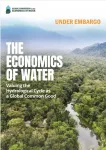(Press-News.org) Individuals with multiple long-term conditions are two and a half times more likely to die following COVID-19 infection than others. When children were assessed separately the risk for mortality among those with multiple long-term conditions increased to almost three times (2.8) the risk of those without. The mortality rates are 22% and 8% respectively.
That is according to an authoritative systematic review and meta-analysis of over four million patients with COVID-19 published today (Thursday 17 October) in the Journal of the Royal Society of Medicine.
The authors are calling for patients with multiple long-term conditions to be prioritised in healthcare policies.
This systematic review is believed to have considered the largest ever cohort of patients with COVID-19 in a study investigating the impact of multiple long-term conditions. The review synthesised evidence from 111 observational studies of patients with confirmed COVID-19 published between January 2020 and May 2023. These studies were conducted across 51 countries and most involved high risk or hospitalised patient cohorts with COVID-19, which could account for the high rates of mortality found in the study.
This major study thus provides an updated picture of the impact of COVID-19 for people with multiple long-term conditions.
While previous research has identified risk factors for severe COVID-19 disease - such as older age, male sex, socioeconomic deprivation, being from an ethnic minority background and having a pre-existing condition - there has been limited research into, or reporting of, the outcomes for patients with multiple long-term conditions. The authors say this should be a matter of growing concern as a third of adults globally – and more than a quarter in England - have two or more long-term health conditions.
This major review found that following COVID-19 infection, and relative to people with a single or no long-term condition, patients with multiple long-term conditions have:
2.4 times higher chance of hospitalisation in all ages and specifically 3.5 times higher in children
1.8 times greater chance of needing mechanical ventilation in all ages and 4.3 times higher in children, specifically
1.2 times higher chance of admission to Intensive Care Unit in all ages and 2.9 times greater in children.
Dr Shukrat Salisu-Olatunji, a PhD student at the University of Leicester and funded by the National Institute for Health and Care Research (NIHR) Applied Research Collaboration (ARC) East Midlands, was the lead author of the study. She said:
“Our systematic review and meta-analysis demonstrated that there is a significantly higher risk of adverse COVID-19 outcomes for people living with multiple long-term conditions, compared with those without. Furthermore, relative to those without pre-existing long-term conditions, children and young people with multiple long-term conditions experienced more adverse COVID-19 outcomes. This may suggest that increased vulnerabilities could be associated more with the extremes of age rather than simply older age, as has been previously reported.
“We hope that health policies will prioritise people with multiple long-term conditions, especially in times of public health emergencies such as the COVID-19 pandemic.”
Professor Kamlesh Khunti, Director of NIHR ARC East Midlands and a senior author of the paper commented:
“This study puts into the spotlight the high risk of poorer outcomes for people with multiple long-term conditions. This systematic review is timely as the publication of the recent NHS Darzi Review highlights the biggest challenge facing the nation as the ageing population, who are living longer often in ill-health with multiple long-term conditions.”
COVID-19-related morbidity and mortality in people with multiple long-term conditions: a systematic review and meta-analysis of over 4 million people is published by the Journal of the Royal Society of Medicine. Its authors are: Shukrat Salisu-Olatunji, Yogini Chudasama, Navjot Kaur, Zara Kayani, Babatunde Odugbemi, Olasope Esther Bolodeoku, Shirley Akua Konnor, Elpida Vounzoulaki, Atanu Bhattacharjee, Radia Fahami, Jonathan Valabhji, Amitava Banerjee, Francesco Zaccardi, Clare Gillies and Kamlesh Khunti. DOI 10.1177/01410768241261507.
END
Children with multiple long-term conditions hospitalized with COVID are almost three times more likely to die: New study
2024-10-16
ELSE PRESS RELEASES FROM THIS DATE:
8% GDP loss by 2050 foreseen due to world water crisis; more than 50% of food production at risk: Global Commission on the Economics of Water
2024-10-16
Paris — An international group of leaders and experts warns that unless humanity acts with greater boldness and urgency, an increasingly out-of-balance water cycle will wreak havoc on economies and humanity worldwide.
In a landmark report, The Economics of Water: Valuing the Hydrological Cycle as a Global Common Good, the Global Commission on the Economics of Water says the water crisis puts at risk more than half of the world’s food production by 2050. It also threatens an 8% loss of GDP in countries around the world on average by 2050, with as much ...
Nanoparticle therapy offers new hope for prostate cancer patients
2024-10-16
Prostate cancer is the second leading cause of cancer death among American men.
A ground-breaking study, conducted by researchers from the University of Virginia, Mount Sinai, the University of Michigan, the University of Texas and others, has demonstrated the clinical success of a new nanoparticle-based, laser-guided therapy for prostate cancer treatment.
The study, which involved 44 men with localized prostate cancer, used gold nanoshellss in combination with magnetic resonance imaging (MRI) and ultrasound fusion — an ...
UVA researchers engineer AI breakthrough in human action detection technology
2024-10-16
What if a security camera could not only capture video but understand what’s happening — distinguishing between routine activities and potentially dangerous behavior in real time? That’s the future being shaped by researchers at the University of Virginia’s School of Engineering and Applied Science with their latest breakthrough: an AI-driven intelligent video analyzer capable of detecting human actions in video footage with unprecedented precision and intelligence.
The system, called the Semantic and Motion-Aware Spatiotemporal Transformer Network (SMAST), promises a wide range of ...
Bolstering the fight against antibiotic-resistant bacteria
2024-10-16
GAINESVILLE, Fla. — University of Florida Health scientists exploring how combinations of antibiotics can fight resistant bacteria have been awarded an $11.8 million grant for work that could help save the tens of thousands of lives lost yearly to infections that are increasingly plaguing humanity.
The National Institutes of Health, or NIH, grant to the UF College of Medicine and the UF College of Pharmacy will support scientists working to uncover the mechanics of how bacteria and antibiotics interact, down to the molecular level.
That mechanistic knowledge ...
Deep learning illuminates atmospheric blocking events of past, future
2024-10-16
Atmospheric blocking events are persistent, high-impact weather patterns that occur when large-scale high-pressure systems become stationary and divert the jet stream and storm tracks for days to weeks, and can be associated with record-breaking flooding or heat waves, such as in Europe in 2023. In a new study, University of Hawai‘i at Mānoa atmospheric scientist Christina Karamperidou used a deep learning model to infer the frequency of blocking events over the past 1,000 years and shed light on how future climate change may impact these significant phenomena.
“This study set out to extract a paleoweather signal from ...
Kidney transplantation among those with HIV infections shown safe and effective
2024-10-16
It is just as safe and effective for people with HIV in need of kidney transplantation to get their organ from donors who are also HIV positive as it is from donors who are not infected with the virus, a new study shows. Survival rates for organ recipients one and three years after the procedure were the same for donors with or without HIV. Also the same were risks of serious side effects, such as infection, fever, and rejection in the donated organ.
In what is the largest comparative trial of the experimental procedures since the first transplant was performed in the United States in 2016, researchers ...
Longer-term data from SWOG S1826 trial confirm nivolumab-AVD benefit in Hodgkin lymphoma
2024-10-16
In mid-2023, the SWOG S1826 phase 3 trial in advanced Hodgkin lymphoma reported highly positive primary results earlier than expected, after the trial’s second planned interim analysis found the preset threshold for efficacy had already been reached.
Now, a follow-up analysis with additional data – a median follow-up of 2.1 years – confirms the durability of those initial findings: among the 970 newly diagnosed adolescents and adults randomized to the trial, those who received a combination of nivolumab plus AVD chemotherapy (N-AVD) had a significantly lower risk of cancer progression ...
In landmark study, immunotherapy boosts survival of advanced Hodgkin lymphoma
2024-10-16
A treatment that rallies the immune system to destroy cancer raised the survival rate for advanced Hodgkin lymphoma patients to a remarkable 92 percent, suggesting a new standard therapy for the disease. The New England Journal of Medicine published the innovative clinical trial results this week.
Young people are most at risk to get Hodgkin lymphoma, an uncommon blood and immune system cancer that falls within the general category of lymphomas. With this new treatment, scientists believe they ...
Kidney transplantation between donors and recipients with HIV is safe
2024-10-16
WHAT:
Kidney transplantation from deceased donors with HIV (HIV D+) to recipients with HIV (HIV R+) was safe and comparable to kidney transplantation from donors without HIV (HIV D-) in a multicenter observational study in the United States. The clinical outcomes observed were consistent with smaller pilot studies, but this National Institutes of Health (NIH)-funded clinical trial was the first statistically powered to demonstrate noninferiority, which means that an approach being studied is as good as standard clinical practice. The results were published today ...
Brown researchers show how gut hormones control aging in flies and how it relates to human biology
2024-10-16
PROVIDENCE, R.I. [Brown University] — Biologists at Brown University have discovered how a neuropeptide hormone made in the gut of flies can control their lifespan.
The findings, published in PNAS, have implications for humans, too, the researchers say — especially as new diabetes and obesity medications based on gut hormones in the same family of the fly hormone are becoming more widespread.
For the past two decades, study author Marc Tatar, a professor of biology affiliated with the Center on the Biology of Aging at Brown University, has studied how the hormones insulin and insulin-like ...





